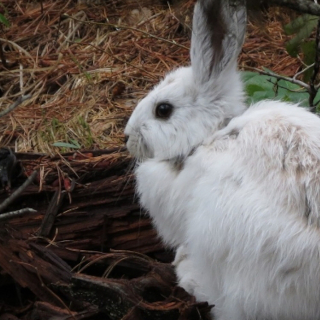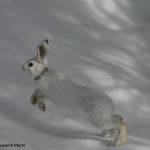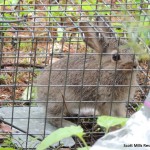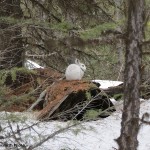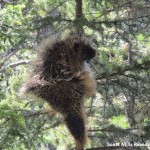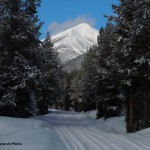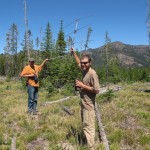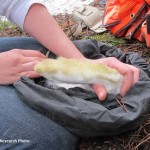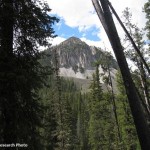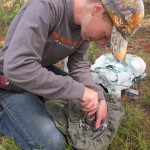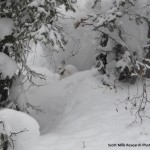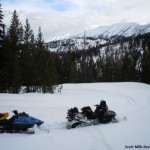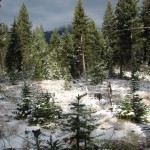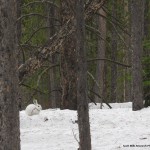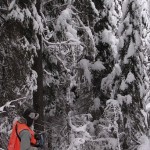Coat Color Phenology and Climate Change
[Amanda Emmel, Lindsey Barnard, Hannah Walker, Marketa Zimova, Alex Kumar, Brandon Davis, Jennifer Feltner, Diana Lafferty, Eugenia Bragina and numerous technicians, undergrads and other collaborators]
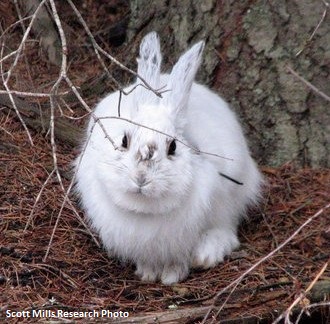 We know from ecological-first principles that wildlife populations will respond in one of three ways to rapid climate change: They will move, adapt, or die. The middle option—the potential for local adaptation through either plasticity or natural selection—is poorly understood and seldom considered in the context of climate change. Snowshoe hares are under strong selection to avoid mortality due to predation, and have population dynamics driven by mortality. Their seasonal color molt to winter white—timed by photoperiod—is confronting one of the strongest signals of climate change, a reduction in duration of winter snowpack. This could lead to camouflage mismatch between white hares and snowless ground, with resulting mortality. And yet, hares may have capacity to successfully respond to potential mismatch through both plasticity (in coat color timing and behaviors) and natural selection. The timing of the color molt is geographically variable for about 20 species around the world (ranging from hares to ptarmigan to weasels to arctic fox). Interestingly, some populations do not change color, an ideal situation for linking field studies, downscaled snowpack predictions, and gene expression and hormonal mechanistic studies to unravel the role of genetic variation and plasticity in driving the timing of the coat color change.
We know from ecological-first principles that wildlife populations will respond in one of three ways to rapid climate change: They will move, adapt, or die. The middle option—the potential for local adaptation through either plasticity or natural selection—is poorly understood and seldom considered in the context of climate change. Snowshoe hares are under strong selection to avoid mortality due to predation, and have population dynamics driven by mortality. Their seasonal color molt to winter white—timed by photoperiod—is confronting one of the strongest signals of climate change, a reduction in duration of winter snowpack. This could lead to camouflage mismatch between white hares and snowless ground, with resulting mortality. And yet, hares may have capacity to successfully respond to potential mismatch through both plasticity (in coat color timing and behaviors) and natural selection. The timing of the color molt is geographically variable for about 20 species around the world (ranging from hares to ptarmigan to weasels to arctic fox). Interestingly, some populations do not change color, an ideal situation for linking field studies, downscaled snowpack predictions, and gene expression and hormonal mechanistic studies to unravel the role of genetic variation and plasticity in driving the timing of the coat color change.
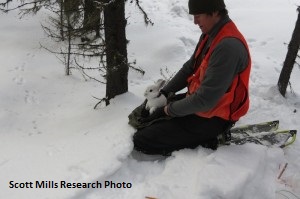 We have shown that color mismatched hares are more likely to be killed by predators, a fitness cost that would translate to steep population declines over the next century without adaptive rescue. Further, we are interested how different logging treatments will affect snowshoe hares in terms of mismatch and if behavioral plasticity plays a role in reducing color mismatch. At the same time, we have ongoing collaborations to use next-generation DNA sequencing and transcriptomics to unravel the genetic basis of seasonal coat color change. Ultimately, we will link spatially explicit projections of future snow cover at ecologically relevant scales with our empirical measures of past and present selection and genetic adaptation to predict how hares are likely to be affected by climate change.
We have shown that color mismatched hares are more likely to be killed by predators, a fitness cost that would translate to steep population declines over the next century without adaptive rescue. Further, we are interested how different logging treatments will affect snowshoe hares in terms of mismatch and if behavioral plasticity plays a role in reducing color mismatch. At the same time, we have ongoing collaborations to use next-generation DNA sequencing and transcriptomics to unravel the genetic basis of seasonal coat color change. Ultimately, we will link spatially explicit projections of future snow cover at ecologically relevant scales with our empirical measures of past and present selection and genetic adaptation to predict how hares are likely to be affected by climate change.
While much of our coat color phenology work to date has been focused on snowshoe hares in Montana, we are actively expanding this work to new areas – including Washington, West Virginia, Scotland, Sweden, and much of the northern hemisphere – and to new species, including arctic fox, other hare species and long-tailed weasel. Ultimately, we hope to gain a global perspective on coat color phenology and the potential impacts of climate change by building collaborations to study all 21 seasonal coat color changing species around the world.
Publications and data from this research area
News and media coverage:
- Our 2018 Science article has been recommended as being of special significance in its field - to learn more click here:

- The New York Times
- The Atlantic
- BBC - Science in Action
- National Geographic
- The Weather Channel
- ResearchGate
- The Missoulian
- Yale Climate Connections
- State of the Planet (Earth Institute, Columbia University)
- Nature Ecology and Evolution
- Northwest News Network
- Missoula Current
- Jefferson Public Radio
- The Weather Network
- Times Colonist
- The National Post
- Science Daily
- Carbon Brief
- Phys.org
- Red Deer Advocate
- KSEN AM
- Iran Daily
- Muslim Times
- Deustche Welle
- Science ORF
- Wiener Zeitung
- Die Presse
- Kronen Zeitung
- derStandard
- Newsclick (India)
- Our Research is Highlighted in the Netflix Series: "Life in Colour" with David Attenborough
- Mills Lab coat color research featured in September 2018 SciShow video with Hank Green
- Scott Mills contributes his insights from our coat color research to the PNAS News Feature, "Probing the limits of 'evolutionary rescue'"
- Science Magazine blog post on our June 2018 Science Paper: "Adaptive Introgression Underlies Polymorphic Seasonal Camouflage in Snowshoe Hares SD Version B"
- Video produced by the 2018 International Film Festival on the origin of our coat color work and on our March 2018 Science Paper on “Identifying Global Hot Spots for Evolutionary Rescue from Climate Change”
- Video on our June 2018 Science Paper: "Adaptive Introgression Underlies Polymorphic Seasonal Camouflage in Snowshoe Hares SD Version B"
- Video and Interpretive Dance: "Can hares keep up with climate change?"
